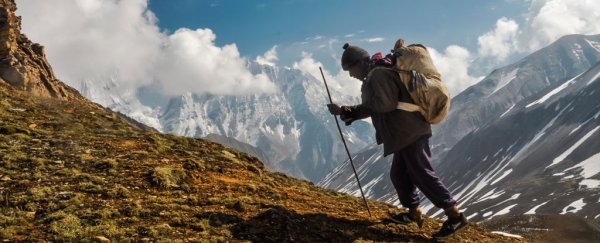The physiology of Himalayan Sherpas has evolved over thousands of years to help them become virtually superhuman mountain climbers, nimbly guiding and assisting others who seek to ascend the extreme heights of Mount Everest.
But what is it in their biology that enables them to overcome the hypoxia (oxygen deficiency) and altitude sickness that plague so many who visit the famous peak? According to a new study, Sherpas are more efficient at using oxygen to power their bodies, giving them a natural advantage over 'lowlanders' who come from environments at sea level.
"Sherpas have spent thousands of years living at high altitudes, so it should be unsurprising that they have adapted to become more efficient at using oxygen and generating energy," says physiologist Andrew Murray from the University of Cambridge in the UK.
"When those of us from lower-lying countries spend time at high altitude, our bodies adapt to some extent to become more 'Sherpa-like', but we are no match for their efficiency."
As part of a research expedition called Xtreme Everest 2, Murray and his team studied the physiology of two groups making the ascent to Everest Base Camp, situated at an elevation of 5,300m (about 17,400 ft).
One of the groups was made up of 10 mostly European researchers making up the expedition party, while the other consisted of 15 Sherpas native to the region.
Blood and muscle biopsies were taken from the participants prior to the ascent – in London for the researchers, and at Kathmandu, Nepal, for the Sherpas – in order to get a baseline measurement of their metabolism in low-lying areas.
New readings were then taken once the group climbed to Everest Base Camp, with final measurements taken after two months of acclimatising there.
The readings showed that even at baseline altitudes, the Sherpas' mitochondria – the organelles often dubbed the 'powerhouse of cell' – were more efficient at producing the chemical adenosine triphosphate (ATP), which enables energy transfer within cells.
In addition, the Sherpas revealed lower levels of fat oxidation – suggesting they were better at generating energy from sugars, rather than from fat, which is less efficient.
"Fat is a great fuel, but the problem is that it's more oxygen-hungry than glucose," Murray told Roland Pease at BBC News.
"It was pretty clear straight away that our tissue experiments were showing different metabolisms for the two groups," added another of the team, James Horscroft.
"In fact, the difference was so astounding we were worried if the tests were working."
These readings didn't change much for the Sherpas as they ascended the mountain environment, but the measurements did gradually change for the lowlanders group on the whole, showing that they were slowly acclimatising to the altitude.
The researchers attribute some of the Sherpas' altitude advantages to a gene variation in the peroxisome proliferator-activated receptor A (PPARA) gene, which favours glucose over fat when it comes to generating energy.
"It's not down to one gene, of course. We see better blood flow through the capillaries; and [Sherpas] appear to have a richer capillary network as well so that the oxygen can be delivered better to the tissues," Murray said.
"But this gene would also have given them some advantage."
While the researchers don't think we'll all necessarily be able to become superhuman mountaineers in the future, it's possible the findings could help us to develop new ways of treating hypoxia.
In addition to affecting mountain climbers, the condition endangers hospital patients, with as many as one in five patients in intensive care units in the UK dying from lack of oxygen during emergencies, according to one of the team, Mike Grocott from the University of Southampton.
"By understanding how Sherpas are able to survive with low levels of oxygen, we can get clues to help us identify those at greatest risk in ICUs," he explains in a press release, "and inform the development of better treatments to help in their recovery."
The findings are reported in Proceedings of National Academy of Sciences.
